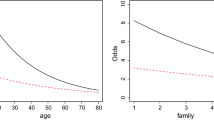Abstract
Ridit analysis is statistical method for comparing ordinal-scale responses. In this paper, the extact variance and asymptotic distribution of the average ridit is developed, including the cases in which the reference group is sampled or the comparison group is finite. The appropriate use and interpretation of ridit analysis is also discussed.
Similar content being viewed by others
References
Agresti, A. (1984).Analysis of ordinal categorical data. New York: Wiley.
Brockett, P. L. (1981). A note on the numerical assignment of scores to ranked categorical data.Journal of Methematical Sociology, 8, 91–101.
Brockett, P. L., & Levine, A. (1977). On a characterization of ridits.Annals of Statistics, 5, 1245–1248.
Bross, I. D. J. (1958). How to use ridit analysis.Biometrics, 14, 18–38.
Cochran, W. G. (1977).Sampling techniques (3rd ed.). New York: Wiley.
Davidson, R. C. (1984). Dissatisfaciton of women family practice residents.Family Medicine, 16, 10–12.
Dennis, T. B., Bore, M. D., & Terrell, G. R. (1980). Some properties of the ridit transformation. American Statistical Association.Proceedings of the statistical computation section, pp. 303–308.
Fleiss, J. L. (1981).Statistical methods for rates and proportions (2nd ed.). New York: Wiley.
Fleiss, J. L., Chilton, N. W., & Wallenstein, S. (1979). Ridit analysis in dental clinical studies.Journal of Dental Research, 58, 2080–2084.
Golden, L. L., & Brockett, P. L. (1987). The effect of alternative scoring methods on the analysis of rank order categorical data.Journal of Mathematical Sociology, 12, 383–414.
Graubard, B. I., & Bork, E. L. (1987). Choice column scores for testing independence in ordered 2 ×K contingency tables.Biomertics, 43, 471–476.
Hájek, J. (1960). Limiting distributions in simple random sampling from a finite population.Magyar Tudományos Akadémia, Matematikai Kutató Intézténk Kozlemányei, V (A, fascicle 3), 361–371.
Jansen, M. E. (1984). Ridit analysis: A review.Statistica Neerlandica, 38, 141–158.
Lehman, E. L. (1975).Nonparmetrics: Statistical methods based on ranks, San Franciso: Holden-Day.
Levine, A., Roizen, P., Rozé, P., & Christensen, H. (1972). A mathematical method for analyzing questionnaires.Bulletin of the World Health Organization, 47, 87–97.
Lynch, G. W. (1978). A decision theoretic approach to ridits.Communications in Statistics-Theory and Methods, 7A, 607–614.
Mantel, N. (1979). Ridit analysis and related ranking priocedures—Use at your own risk.American Journal of Epidemiology, 109, 25–29.
Selvin, S. (1977). A further note on the interpretation of ridit analysis.American Journal of Epidemiology, 105, 16–20.
Selvin, S. (1979). Reply to Mantel (1979).American Journal of Epidemiology, 109, 29–30.
Zimmerman, S., & Johnston, D. A. (1974). Nonparametric tests and ridits.Journal of Periodontal Research, 9 (Supplement 14), 193–206.
Author information
Authors and Affiliations
Corresponding author
Additional information
The authors wish to thank Andrew Klugh for this support, and the references and David Feigenbaum for their very helpful comments.
Rights and permissions
About this article
Cite this article
Beder, J.H., Heim, R.C. On the use of ridit analysis. Psychometrika 55, 603–616 (1990). https://doi.org/10.1007/BF02294610
Received:
Revised:
Issue Date:
DOI: https://doi.org/10.1007/BF02294610




